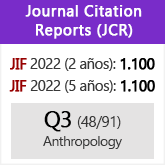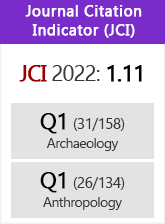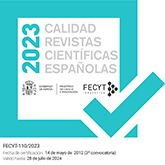Plata semirrefinada para los plateros de la Edad del Hierro en el Mediterráneo: un mecanismo para identificar la plata ibérica
DOI:
https://doi.org/10.3989/tp.2019.12237Palabras clave:
Península ibérica, Fenicios, Lingote, La Rebanadilla, Análisis de composición, Isótopos de plomoResumen
Un fragmento de lingote de plata descubierto recientemente en el yacimiento fenicio de La Rebanadilla (Málaga) ha sido investigado mediante isotopos de plomo y análisis elemental.El lingote recuperado en los niveles inferiores del yacimiento, se fecha potencialmente entre fines del siglo XI y el IX a.C., situándose en cronología similar a algunos depósitos de hacksilver del área del levante mediterráneo.La edad de la corteza calculada a partir de los isotopos de plomo y la composición señalan que el lingote fue obtenido de minerales de Edad Hercínica con concentraciones altas de bismuto.Esta signatura es compatible con la de la Faja Pirítica del suroeste de la península ibérica, en particular con la de las antiguas minas de la zona de Riotinto.Se propone que la plata de este lingote fue obtenida de las jarositas argentíferas de Riotinto, donde sufrió solo un primer refinado mediante copelación, conservando un alto contenido en plomo antes de ser comercializado hacia La Rebanadilla, que pudo ser un lugar potencial para su transporte hacia los territorios fenicios en el Mediterráneo oriental. Las implicaciones del transporte de plata sin refinar son discutidas en relación al comercio de la plata por los fenicios durante la Edad del Hierro en el Mediterráneo y la dificultad de identificar la plata ibérica en el registro arqueológico.
Descargas
Citas
Albarède, F.; Desaulty, A.-M and Blichert-Toft, J. 2012: "A geological perspective on the use of Pb isotopes in archaeometry". Archaeometry 54, 853-867. https://doi.org/10.1111/j.1475-4754.2011.00653.x
Allan, J. 1970: Considerations on the antiquity of mining in the Iberian Peninsula. Royal Anthropological Institute Occasional paper, 27.
Anguilano, L. 2012: Roman lead and silver smelting at Riotinto: the case study of Corta Lago. PhD. thesis, University College London. http://discovery.ucl.ac.uk/id/eprint/1348305
Antolinos, J. A. 2003: "La zone minière de Mazarrón (Murcia)". In A. Orejas (dir.): Atlas historique des zones minières d'Europe II. Dossier 1T: 1-14. Commission Européenne. Action COST G2 "Paysages anciens et structures rurales". Luxemburg.
Arancibia Román, A.; Galindo San José, L.; Juzgado Navarro, M.; Dumas Peñuelas, M. and Sánchez-Moreno, V. M. S. 2011: "Aportaciones de las últimas intervenciones a la arqueología fenicia de la Bahía de Málaga". In M. Álvarez Martí-Aguilar (ed.): Fenicios en Tartessos: nuevas perspectivas: 129-149. British Archaelogical Reports International Series 2245, Archaeopress.Oxford.
Bachmann H. G. 1993: "The archaeometallurgy of silver". In R. Francovich (ed.): Archeologia delle Activittrí Estrattive e Metallurgiche.Edizioni all'insegna del Giglio. Florence: 487-497.
Craddock, P. T. 1995: Early metal mining and production. Edinburgh University Press, Edinburgh.
Craddock, P. T. 2014: "Production of silver across the ancient world". ISIJ International 54: 1085-1092. https://doi.org/10.2355/isijinternational.54.1085
Craddock, P. T., Freestone, I. C. and Hunt Ortiz, M. 1987: "Recovery of silver from speiss at Riotinto (SW Spain)". Institute for Archaeo-Metallurgical Studies Newsletter, https://www.ucl.ac.uk/iams/newsletter/accordion/journals/ iams_10_11/iams_10-11_1987_craddock_freestone_ortiz
Dayton, J. E. 1978: Minerals, metals, glazing and man. Harrap. London.
Desaulty, A-M.; Telouk, P.; Albalat, E. and Albarède, F. 2011: "Isotopic Ag-Cu-Pb record of silver circulation through 16th-18th century Spain". Proceedings of the National Academy of Sciences 108: 9002- 9007. https://doi.org/10.1073/pnas.1018210108 PMid:21606351 PMCid:PMC3107326
Domergue, C. 1990: Les mines de la péninsule Ibérique dans l'antiquité Romaine. Collection de l'Ecole Française de Rome 127. Rome.
Dutrizac, J. E.; Jambor, J. L. and O'Reilly, J. B. 1985: "Man's first use of Jarosite: the pre-Roman mining-metallurgical operations at Riotinto, Spain". Canadian Institute of Mining, Metallurgy and Petroleum Bulletin 76 (859): 78-82.
Eshel, T.; Erelc, Y.; Yahalom-Mackd, N.; Tiroshc, O. and Gilboa, A. 2019: "Lead isotopes in silver reveal earliest Phoenician quest for metals in the west Mediterranean". Proceedings of the National Academy of Sciences 116 (13): 6007-6012. https://doi.org/10.1073/pnas.1817951116 PMid:30804182 PMCid:PMC6442568
Gale, N. H.; Gentner, W. and Wagner, G. A. 1980: "Mineralogical and Geographical silver sources of archaic Greek coinage". In D. M. Metcalf and W. A. Oddy (eds.): Metallurgy in Numismatics I, The Royal Numismatics Society. London: 3-50.
Gale, N. H. and Stos-Gale, Z. A. 1981: "Cycladic lead and silver metallurgy". The Annual of British School at Athens 76: 169-224. https://doi.org/10.1017/S0068245400019523
Gómez Toscano, F. and Mederos Martín, A. 2018: "The resumption of the exchanges between the Eastern and Western Mediterranean after the crisis of the XIIth century BC. A fragment of Late Helladic/Minoan IIIC wheel-made painted pottery in Huelva (1150-1050 BC)".Cuadernos de Prehistoria y Arqueología 44: 115-131. https://doi.org/10.15366/cupauam2018.44.006
González de Canales, F.; Serrano, L. and Llompart, J. 2004: El emporio fenicio precolonial de Huelva (ca.900-770 a.C.).Biblioteca Nueva. Madrid.
González de Canales, F.; Serrano, L. and Llompart, J. 2008: "The emporium of Huelva and Phoenicians chronology: Present and future possibilities". In C. Sargona (ed.): Beyond the homeland: markers in phoenician chronology. Ancient Near Eastern Studies Supplement 28. Leuven: 633-655.
Hodos, T. 2009: "Colonial engagements in the Global Mediterranean Iron Age". Cambridge Archaeological Journal 19: 221-241. https://doi.org/10.1017/S0959774309000286
Hunt Ortiz, M. A. 2003: Prehistoric mining and metallurgy in south west Iberian Peninsula.British Archaeological Reports International Series 1188, Archaeopress. Oxford.
Kassianidou, V. 2003: "Extraction of silver from complex poly-metallic ores. The evidence from Monte Romero". In P. Craddock and J. Lang (eds.): Mining and metal production through the Ages. The British Museum Press. London: 198-206.
Kassianidou, V. and Knapp, A. B. 2005: "Archaeometallurgy in the Mediterranean: The social context of mining, technology, and trade". In E. Blake and A. B. Knapp (eds.): The archaeology of Mediterranean prehistory.Blackwell Publishing. Padstow, Cornwall: 215-251. https://doi.org/10.1002/9780470773536.ch9
Kourou, N. 2012: "Cypriots and Levantines in the Central Aegean during the Geometric Period; The nature of contact". Mediterranean Archaeology 25: 215-227.
L'Heritier, M.; Baron, S.; Cassayre, L. and Tereygeol, F. 2015: "Bismuth behaviour during ancient processes of silver-lead production". Journal of Archaeological Science 57: 56-68. https://doi.org/10.1016/j.jas.2015.02.002
Marcoux, E. 1998: "Lead isotope systematics of the giant massive sulphide deposits in the Iberian Pyrite Belt". Mineralium Deposita 33: 45-58. https://doi.org/10.1007/s001260050132
Meyers, P. 2003: "Production, distribution, and control of silver: information provided by elemental composition of ancient silver objects". In L. van Zelst (ed.): Patterns and Process: a festschrift in Honor of Dr Edward V.Sayre. Smithsonian Center for Materials Research and Education. Washington, D.C: 271-288.
Montero Ruiz, I.; Rovira, S. and Gómez Ramos, P. 1995: "Plata argárica". Boletín de la Asociación Española de Amigos de la Arqueología 35: 97-106.
Murillo-Barroso, M. 2013: Producción y consumo de plata en la península ibérica. Un análisis comparativo entre la sociedad argárica y los primeros asentamientos orientalizantes. Ph.D.Thesis. Universidad de Granada. Granada. http://hdl.handle.net/10481/29425
Murillo-Barroso, M.; Montero-Ruiz, I. and Bartelheim, M. 2014: "Native silver resources in Iberia". In H. H. Meller, R. Risch and E. Pernicka (eds.): Metals of power - early gold and silver. Tagungen des Landesmuseums für Vorgeschichte Halle, 11/ I. Halle: 257-268.
Murillo-Barroso, M.; Montero-Ruiz, I.; Rafel, N.; Hunt Ortiz, M. A. and Armada, X-L. 2016: "The macro-regional scale of silver production in Iberia during the First Millennium BCE in the context of Mediterranean contacts. Oxford Journal of Archaeology 35: 75-100. https://doi.org/10.1111/ojoa.12079
Oxalid. Oxford Archaeological Lead Isotope Database from the Isotrace Laboratory. 2019. http://oxalid.arch.ox.ac.uk/default.html (accessed june 26, 2019).
Pappa, E. 2012: "Framing some aspects of the Early Iron Age 'Chronological mess': Aegean synchronisms with the West and their significance for the Greek Geometric series". Kubaba 3: 2-38.
Patterson, C. C. 1971: "Native copper, silver, and gold accessible to early metallurgists". American Antiquity 36: 286-321. https://doi.org/10.2307/277716
Pernicka, E. 1981: "Archaometallurgische untersuchungen zur antiken silbergewinnung in Laurion". Erzmetall 36: 592-597.
Polzer, M. E. 2014: "The Bajo de la Campana shipwreck and colonial trade in Phoenician Spain". In J. Aruz, S. B. Graff and Y. Rackic (eds.): Assyria to Iberia at the dawn of the Classical Age. The Metropolitan Museum of Art. New York: 230-242.
Pomiès, C.; Cocherie, A.; Guerrot, C.; Marcoux, E. and Lancelot, J. 1998: "Assessment of the precision and accuracy of lead-isotope ratios measured by TIMS for geochemical applications: example of massive sulphide deposits (Riotinto, Spain)". Chemical Geology 144: 137-49. https://doi.org/10.1016/S0009-2541(97)00127-7
Renzi, M. 2013: La metalurgia del yacimiento fenicio de La Fonteta (Guardamar del Segura, Alicante). Bibliotheca Praehistorica Hispana XXIX, Editorial CSIC. Madrid.
Renzi, M.; Montero-Ruiz, I. and Bode, M. 2009: "Non-ferrous metallurgy from the Phoenician site of La Fonteta (Alicante, Spain): a study of provenance". Journal of Archaeological Science 36: 2584- 2596. https://doi.org/10.1016/j.jas.2009.07.016
Rothenberg, B. and Blanco-Freijeiro, A. 1981: Studies in ancient mining and metallurgy in South-West Spain: explorations and excavations in the province of Huelva.The Institute of Archaeo-Metallurgical Studies. London.
Rovira Llorens, S. and Montero Ruiz, I. 2018: "Proyecto Arqueometalurgia de la Península Ibérica (1982-2017)". Trabajos de Prehistoria, 75 (2): 223-247. https://doi.org/10.3989/tp.2018.12213
Salkield, L. U. 1982: "The Roman and Pre-Roman slags at Riotinto Spain". In T. A. Wertime and S. F. Wertime (eds.): Early pyrotechnology: The evolution of the first fire-using industries. Smithsonian Institution Press. Washington D.C.: 137-147.
Salkield, L. U. 1987: A technical history of the Riotinto Mines: some notes on exploitation from pre-Phoenician times to the 1950s. The Institute of Mining and Metallurgy. London. https://doi.org/10.1007/978-94-009-3377-4
Sánchez, V. M.; Galindo, L.; Juzgado, M. and Dumas, M. 2011: "La desembocadura del Guadalhorce en los siglos IX y VIII a.C. y su relación con el Mediterráneo". In J. C. Domínguez Pérez (ed.): Gadir y el Círculo del Estrecho revisados.Propuestas de la arqueología desde un enfoque social. Universidad de Cádiz. Cádiz: 185-200.
Sánchez-Moreno, V.; Galindo San José, L.; Navarro, M. J. and Peñuelas, M. D. 2012: "El asentamiento fenicio de la Rebanadilla a finales del siglo IX A.C". In E. G. Alfonso (ed.): Diez años de arqueología fenicia en la provincia de Málaga 2001-2010. Consejería de Cultura y Deporte. Sevilla: 137-170.
Sherratt, S. 2016: "From 'institutional' to 'private': traders, routes and commerce from the Late Bronze Age to the Iron Age". In J. C. Moreno Garcia (ed.): Dynamics of production in the ancient Near East 1300-500BC. Oxbow Books. Oxford: 289-301.
Shepherd, R. 1993: Ancient Mining.Institution of Mining and Metallurgy, Elsevier Applied Science. London and New York.
Stos-Gale, Z. A. 2001: "The impact of the natural sciences on studies of Hacksilber and early silver coinage". In M. Balmuth (ed.): Hacksilber to coinage: new insights into the monetary history of the Near East and Greece. 99th Annual Meeting of the Archaeological Institute of America.Numismatic Studies 24, The American Numismatic Society. New York: 53-76
Williams, D. 1950: "Gossanised breccia ores, jarosites and jaspers at Riotinto, Spain". Transactions of the Institution of Mining and Metallurgy 526: 1-12.
Wood, J. R.; Charlton, M. J.; Murillo-Barroso, M. and Martinón-Torres, M. 2017: "Iridium to provenance ancient silver". Journal of Archaeological Science 81: 1-12. https://doi.org/10.1016/j.jas.2017.03.002
Wood, J. R.; Montero-Ruiz, I. and Martinón-Torres, M. 2019: "From Iberia to the southern Levant: the movement of silver across the Mediterranean in the Early Iron Age". Journal of World Prehistory 32 (1): 1-31. https://doi.org/10.1007/s10963-018-09128-3
Descargas
Publicado
Cómo citar
Número
Sección
Licencia
Derechos de autor 2019 Consejo Superior de Investigaciones Científicas (CSIC)

Esta obra está bajo una licencia internacional Creative Commons Atribución 4.0.
© CSIC. Los originales publicados en las ediciones impresa y electrónica de esta Revista son propiedad del Consejo Superior de Investigaciones Científicas, siendo necesario citar la procedencia en cualquier reproducción parcial o total.Salvo indicación contraria, todos los contenidos de la edición electrónica se distribuyen bajo una licencia de uso y distribución “Creative Commons Reconocimiento 4.0 Internacional ” (CC BY 4.0). Puede consultar desde aquí la versión informativa y el texto legal de la licencia. Esta circunstancia ha de hacerse constar expresamente de esta forma cuando sea necesario.
No se autoriza el depósito en repositorios, páginas web personales o similares de cualquier otra versión distinta a la publicada por el editor.

















